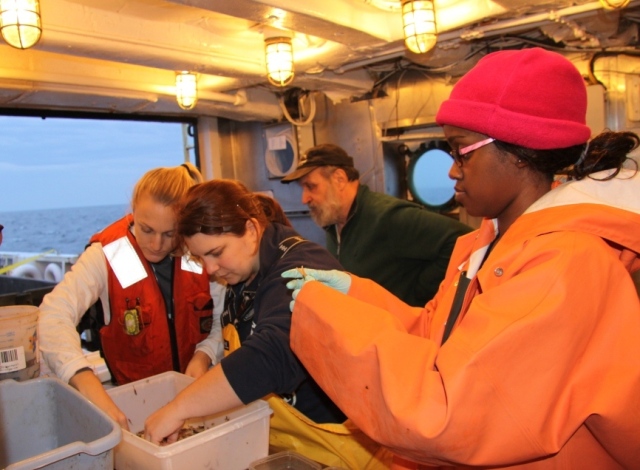Wednesday, March 28, 2012
Tracking marine life migration in the North Atlantic
PRINCESS ANNE, MD – (March 28, 2012) – Students from UMES’ Living Marine Resources Cooperative Science Center spent 10 days at sea in January investigating North Atlantic marine life.
Guided by Dr. Vince Guida, a National Oceanic and Atmospheric Administration biologist, and Dr. Bradley Stevens of UMES, the group set out to document fish and invertebrates from Woods Hole, Mass. south to Virginia Beach, Va.
Using deep sea trawls aboard the Delaware II, a NOAA research vessel, the students captured organisms on the continental shelf at depths ranging from 20 to 200 meters, and on the continental slope at depths from 300 to 900 meters. NOAA routinely surveys this area each spring and fall, but few studies are conducted mid-winter or at depths below 250 meters. The abundance and types of organisms present at that time or depth are not well known, Stevens said.

Of particular interest on this cruise were deep-sea red crabs and monkfish. Both species live at great depths and support modest commercial fishing, but little is known about their life history or biology. Work was conducted around-the-clock and each time one of the deep trawls came up on deck, students sorted and weighed the catch, then separated the different species for cataloging.
Stevens and some students measured crabs, and took blood, eggs, and tissue samples to determine their reproductive status. Graduate student Evan Lindsay, working with Dr. Andrea Johnson of UMES, collected blood, tissues and vertebrae from monkfish to assess their health, age, reproductive status and pollutant burdens. Understanding the biology and reproductive status of these species will lead to improved management and conservation, Stevens said.
Guida is focused on documenting increasing water temperatures and the northward movement of southern species. White shrimp, common south of Cape Hatteras, and several species of fish have been discovered farther north over the past few years.
“One of the most interesting things we caught were transparent larvae of Caribbean spiny lobsters,” Stevens said. “They were over a thousand miles from their place of birth and could only get this far due to warm water extending up the coast.”

Student-researchers were challenged by 10-foot seas during the first few days of the cruise, but persevered. Graduate student Emily Tewes was philosophical about her hands-on experience.
“I think it is really important to have an ‘out-to-sea’ experience and there is a lot to be learned from working with NOAA,” Tewes said. “Not only do you get a feel for what the work is like, but it can help you decide whether this type of work is a good fit for you in the future.”
In addition to Tewes and Lindsay, other student-researchers included Whitney Dyson, Courtney McGeachy and Candace Rogers from UMES; Andrea Stoneman from Delaware State University; and Sarah Bornhoeft, a recent graduate of Salisbury University and UMES.
This is the eighth year NOAA has sponsored the training for marine science students. Future research cruises are uncertain, however, because of federal budget cuts and the planned decomm

